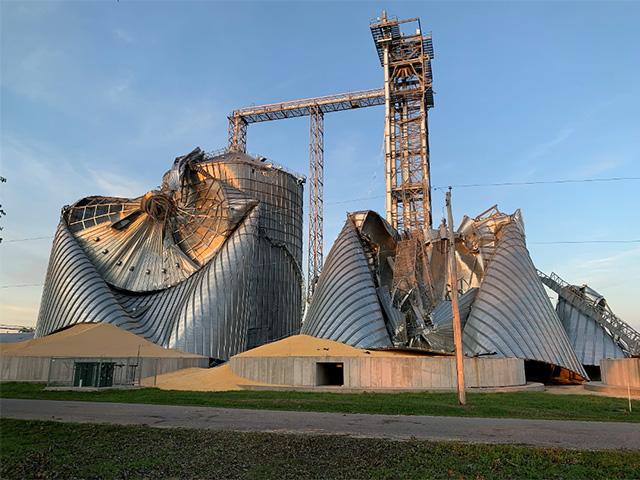Todd's Take
A Drive Down Derecho Way
This past weekend, I had the good fortune of attending the Iowa Governor's Charity Steer Show, held in Ames, Iowa. The event is put on by the Iowa Beef Industry Council and the Iowa Cattleman's Association, and money raised goes to benefit the Ronald McDonald Houses of Iowa. Given the adverse financial climate for beef producers in 2020, I couldn't help but be impressed with their ability to overlook their own current hardships and make this effort help others in need.
I have to admit, the day wasn't all about helping others, as I also had selfish motives on this trip. After Monday's derecho rolled across central Iowa, I was eager to get out and survey western Iowa's storm damage first-hand.
According to an email from the Iowa Department of Agriculture and Land Stewardship on Friday, Aug. 14, Iowa Ag Secretary Mike Naig estimated 36 of Iowa's 99 counties were hardest hit by the derecho and the storm had the greatest impact on 3.57 million acres of corn and 2.5 million acres of soybeans.
In an interview with WNAX farm broadcaster Michelle Rook Saturday at the steer show, Naig said estimating just how much corn was lost was a difficult task and it will take time for insurance claims to be assessed. Realistically, Naig said, we may not know how much was lost until combines roll in the fall (see "Iowa Ag Secretary Revises Estimates on Iowa Storm Damage" at WNAX.com:
Hearing the secretary's comments and memories of 2019 still fresh in my mind, I realized USDA probably won't have a good estimate of Iowa's harvest total until the January World Agricultural Supply and Demand Estimates (WASDE) report ... maybe even later. This seemed as good a time as any to go for a drive.
P[L1] D[0x0] M[300x250] OOP[F] ADUNIT[] T[]
I had already seen fields of downed corn along I-35, between Des Moines and Ames, on the way to the show. Field losses weren't 100%, but some select areas looked as bad as 50% or more. The damage was more random than the wide swath of leveled crops seen in pictures on Twitter.
After the show, with only limited hours of daylight left, I headed east toward Marshalltown, as many at the show recommended. It took a while to see much evidence, but fields did start to look worse near Marshalltown. Most fields were a chaotic mix of bent and broken crops, but some fields closer to town were almost completely flattened, especially if they were on a slope vulnerable to the west wind.
After touring around Marshalltown and seeing various degrees of crop damage, I headed back west. Frankly, I was suspicious and a little frustrated that I hadn't yet seen the worst of the storm.
Heading west from Ames and then eventually south toward Des Moines changed the perspective and quickly gave a taste of how monstrous the storm actually was. Highway 17 south was closed with utility crews working to restore power. A detour west led us to Luther, Iowa, where Heartland Co-op had large bins ripped open with exposed corn sitting in the bottom. Cornfields in the area looked like they were crushed by an army of steam rollers.
There were also strange exceptions. Empty bins were vulnerable and some farm buildings were damaged, but for the most part houses, many farm buildings and Iowa's windmills were mostly untouched. In almost all cases soybean fields looked fine -- at least outwardly -- no matter how devastated the cornfield was next to it.
Keenly aware that I had only seen a small sample of the damage, and also relying on Secretary Naig's estimates, I started to run the numbers: 3.57 million acres of corn in the worst part of the storm times USDA's estimated yield of 202 bushels per acre for the state equals 720 million bushels (mb) of corn -- something close to a worst case scenario estimate.
However, taking the wind path of the storm and multiplying affected corn acres by some expected yield loss was not going to work in this situation. The crop damage was far too variable and select in most cases to broadly categorize.
Confessing to several flaws in Saturday's road tour and realizing much more damage lay to the east, I estimate USDA will eventually lower Iowa's corn production total from 2.74 billion bushels (bb) to 2.4 bb in 2020, a loss of roughly 340 mb. There likely will be some loss to soybeans, but probably not enough to affect soybean prices.
Including smaller crop losses in neighboring states, last week's storm should help relieve some of the bearish pressure corn is currently under. However, as USDA already anticipates 2.76 bb of corn surplus in 2020-21, the market is still a long way from making a bullish case for corn prices. Barring another weather surprise, ending U.S. corn supplies should still be historically high in 2020-21.
There is plenty of room for dissent and I agree with Secretary Naig that harvest will ultimately give us the information we want. Given all the other bearish factors corn is currently facing, it seems reasonable to be cautious about expecting too much of a price rally from last week's storm. But as the storm also reminds us, weather is still a risk and crops are not out of harm's way yet.
Todd Hultman can be reached at Todd.Hultman@dtn.com
Follow him on Twitter @ToddHultman
(c) Copyright 2020 DTN, LLC. All rights reserved.




